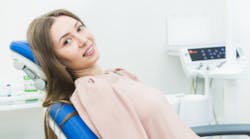How aware are you? The importance of care-based communication
Any motivated dental hygienist will (if not should) continuously strive to be the best possible dental professional he or she can be. As hygienists, we dedicate an immeasurable number of hours to reading, researching, and debating theories, technologies, and sciences, so that we are well-versed and educated. We dedicate time, energy, and money to technologies so that we can be of the highest quality clinically. We will risk musculoskeletal injuries and eye strain just to ensure that each and every pathogenic body and its byproducts are eliminated. As a result, it is common knowledge that hygienists are hardworking, dedicated health-care providers.
Hygienists can be absolutely flawless in these areas, but there is still a defining element of health care missing—care-based communication. Care-based communication is defined as verbal or nonverbal communication with the purpose of enhancing the comfort and well-being of the recipient. Care-based communication often utilizes strategizes such as empathetic awareness, passive leadership, and reflective mirroring. Care-based communication is not an adjunct to health care, but rather a pivotal piece of providing quality care. In any health-care setting, the patient’s needs must be at the forefront of the clinician’s mind, including the patient’s physical and emotional needs. Because the dental office is (and will always be) an intimidating, uncomfortable setting to a reasonable sum of our patients, care-based communication is essential.
One must be mindful when implementing care-based communication because it is an element of care that will not occur unconsciously. It is crucial to recognize that people (much like the dental issues that accompany them) are unique; therefore, the care that we implement must be tailored to the specific needs of the individual seeking treatment. Because of the variabilities between people, each patient must be approached and communicated with in a manner that not only recognizes but also values the patient as an individual with unique needs and limits. The “simple way” (as if working with people is ever simple) to uphold care-based communication is to recognize that your patient has individualized needs and concerns while showing your patient that you are aware and attentive to these. Less simply put, there are a multitude of methods that we can implement including but not limited to, empathetic awareness, passive leadership, and purposeful listening.
Empathetic awareness
Empathetic awareness involves the recognition of the patient’s emotional needs and seeing the patient’s needs at a visceral, individualized level. Empathetic awareness is defined as the pursuit of understanding and sharing the feelings of another individual. In our daily lives as dental hygienists, the platform to engage in empathetic awareness can look varied. It can present itself during the repetitive questioning of a dental procedure or when discussing billing and pricing. In the first scenario, a clinician with empathetic awareness would perceive that a patient was nervous and then proceed to manipulate the treatment or better explain it to manage the patient’s anxiety. In the latter scenario, the clinician would (if utilizing empathetic awareness) approach a sensitive topic with the awareness that every patient has a unique financial situation. The opportunities to engage in active empathetic awareness in a dental office are seemingly everywhere, and it is crucial to engage in them.
Passive leadership
While empathetic awareness focuses more on the comprehension of a situation, passive leadership is a care-based communication method that demands both emotional and physical aspects of the provider. Passive leadership allows the patient to have a sense of control in certain situations, which is crucial for comfort in uncomfortable settings, without compromising the necessary treatment and leadership of the clinician. This can appear in many different ways but ultimately, passive leadership is looking for areas where you can show the patient that they have control. Tangible ways to implement this are sitting while your patient is seated during discussions, allowing the patient to hold the suction, and allowing the patient to see what you see with an intraoral camera. This method not only alleviates the anxiety of a patient but also can be a useful adjunct to the clinician.
Purposeful listening
Purposeful listening is a method of care-based communication that concurrently involves a hygienist’s complete care for his or her patient and provides crucial information for the provider. Purposeful listening can be defined as actively collecting and interpreting communication with the intent to better the care of the patient. It would be difficult to imagine a circumstance where a dental hygienist did not communicate with their patient the entire appointment, but hygienists can easily have an appointment where they don’t listen to their patient. Often times we neglect to remember that the objective of listening is to pursue the words (or lack thereof) communicated and actively process the information rather than just hear the words spoken before they drift away. When we purposefully listen to what our patient is saying, not only do we remind the patient that they are individualized and valued but we also receive information that allows us to implement better care-based communication.
When we implement care-based communication, the emotional needs of our patients are inevitably recognized and managed, which results in a positive experience for both the clinician and the patient. This symbiotic benefit can be tangibly seen in the first smile of an anxious patient, the joy we receive when our patients revel in their newfound confidence, or the unparalleled gratitude given when we help alleviate someone’s fears of dentistry or health care altogether.
We must also recognize that the fruits of our labor are more often than not hidden from us; because of this, we can rest assured that our positivity, empathy, and kindness have purpose and profit for our patients, ourselves, the health-care industry, and our world. It is imperative that our communication is continuously considering the emotional needs of our patients, regardless of who they are. If we enhance the dental experience, we subsequently create a positive association with dental care. This is valuable because when someone has a positive association with something, he or she is more inclined to invest time, energy, and money in it. In theory, the care-based communication that we implement will ultimately enhance the health of our patients and better the health care industry.
As clinicians, we often strive for perfection in our work. This element of perfection requires absolute focus, but this focus can result in a lack of adequate patient management. Therefore, patient awareness and care-based communication must be a constant element of our work. We must be as aware of our patient’s emotional needs as we are of their physical ones because proper treatment does not occur until holistic treatment is implemented. Dental professionals are esteemed, valuable assets to the health-care industry and ultimately the world. The work of a dental professional will be judged by not the outcome of the clinical work, but often the experience provided by the clinician. It is critical that we inherit and adopt a patient-centered philosophy that utilizes care-based communication.
Editor's note: This article first appeared in RDH eVillage. Click here to subscribe.
For the most current dental articles, click here.
About the Author

Matt Sandin
Matt Sandin is an adventurous outdoorsman that feeds his desire to better humanity by providing dental care. When Sandin is not studying dental hygiene at Colorado Northwestern, he is somewhere in the wilderness, creating art, learning, or enjoying the simple beauties of life.

